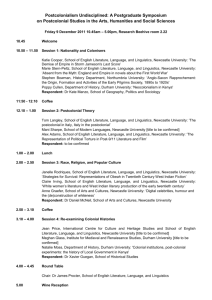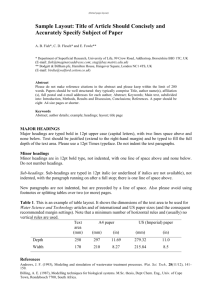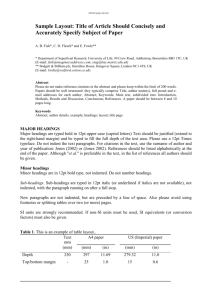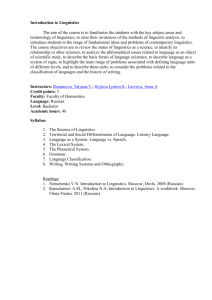Style Sheet - Newcastle University
advertisement
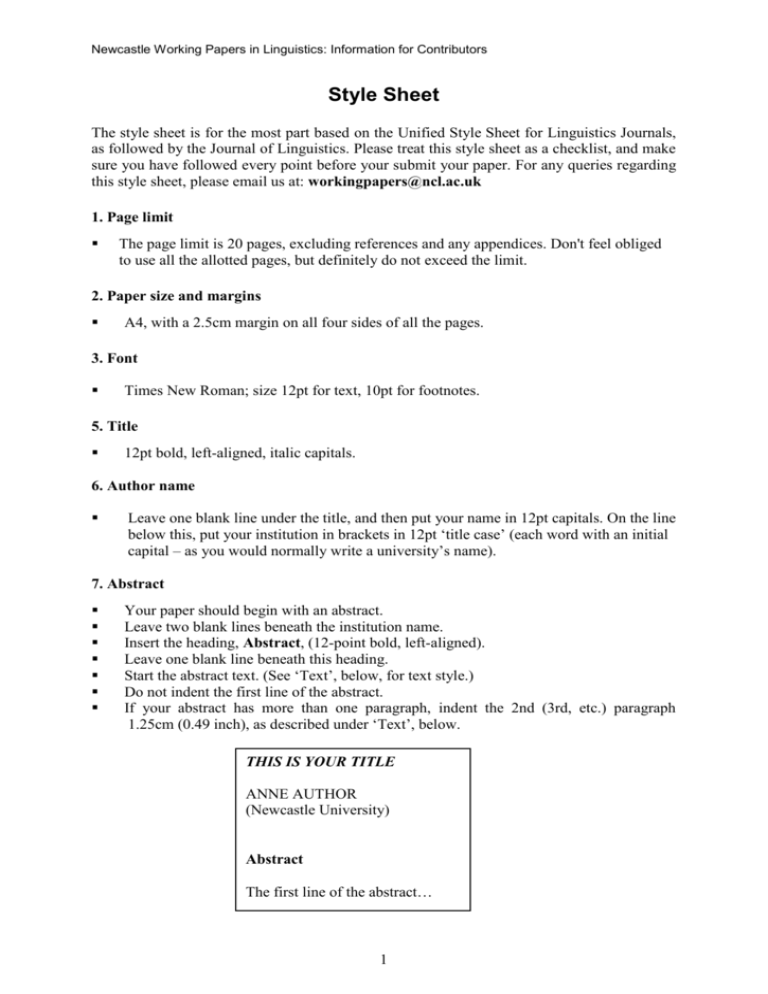
Newcastle Working Papers in Linguistics: Information for Contributors Style Sheet The style sheet is for the most part based on the Unified Style Sheet for Linguistics Journals, as followed by the Journal of Linguistics. Please treat this style sheet as a checklist, and make sure you have followed every point before your submit your paper. For any queries regarding this style sheet, please email us at: workingpapers@ncl.ac.uk 1. Page limit The page limit is 20 pages, excluding references and any appendices. Don't feel obliged to use all the allotted pages, but definitely do not exceed the limit. 2. Paper size and margins A4, with a 2.5cm margin on all four sides of all the pages. 3. Font Times New Roman; size 12pt for text, 10pt for footnotes. 5. Title 12pt bold, left-aligned, italic capitals. 6. Author name Leave one blank line under the title, and then put your name in 12pt capitals. On the line below this, put your institution in brackets in 12pt ‘title case’ (each word with an initial capital – as you would normally write a university’s name). 7. Abstract Your paper should begin with an abstract. Leave two blank lines beneath the institution name. Insert the heading, Abstract, (12-point bold, left-aligned). Leave one blank line beneath this heading. Start the abstract text. (See ‘Text’, below, for text style.) Do not indent the first line of the abstract. If your abstract has more than one paragraph, indent the 2nd (3rd, etc.) paragraph 1.25cm (0.49 inch), as described under ‘Text’, below. THIS IS YOUR TITLE ANNE AUTHOR (Newcastle University) Abstract The first line of the abstract… 1 Newcastle Working Papers in Linguistics: Information for Contributors 8. Text Text should be single-spaced. Text, footnotes, and references should be fully justified. Do not skip a line between paragraphs. The first line of each paragraph should be indented 1.25cm (0.5 inch). (This includes the first paragraph underneath all headings, except for the paragraph underneath the heading, Abstract, as described above.) Use SMALL CAPITALS for emphasis in the main body of the text or footnotes. Titles of books, journals and dissertations in the running text should be in italics. Any language material in the running text should be in italics. The translation or a gloss (where applicable) should immediately follow the example and should be enclosed in single quotation marks, e.g. moja matka ‘my mother’ Terms used in a semi-technical sense or terms whose validity is questioned are enclosed in ‘single quotation marks’. “Double quotation marks’’ are used for quotations within quotations only. 9. Section and subsection headings All headings should be left-justified, 12pt, bold, not underlined. Number your section headings, starting with ‘1’. (Even if your first section heading is Introduction, the number should be ‘1’.) Insert a dot after each section number or subsection number. Leave one blank line after section and sub-section headings. (Except if there is no text between a section heading and a sub-section heading, in which case it is not necessary to leave a blank line after the section heading.) Example: 3. Results The text of section 3 starts here, after one blank line. ... 3.1. Experiment 1 The text of section 3.1 starts here, after one blank line. ... Any headings in numbered examples should be in italics. 10. Examples Examples should be in the same font and font size as the text of the paper. The example number should not be indented. The body of the example should begin 1.25cm (0.49 inch) from the left margin. Where examples are lettered as well as numbered, the letter should be 0.75cm from the left margin. Example: (1) a. Example example. Gloss gloss 'Translation.' 2 Newcastle Working Papers in Linguistics: Information for Contributors Leave one blank line before and after examples. Linguistic category labels appearing in the gloss should be in SMALL CAPITALS not capitals with a reduced font size – go to the Font tab and expand it to find this option in Word 2007. Translation is included in single quotation marks and sentence-final punctuation is within the quotation marks. Examples within the text should be referred to as (4a), (4a, b), (4a-e), (4)-(7). Emphasis in numbered examples should be in bold. Words in the examples should be aligned by using the Tab key, not by inserting spaces. 11. Tables and figures Tables and figures should be in their actual positions in the paper, not placed at the end or on separate pages. Number tables and figures separately, and give each table or figure an informative title. The style for titles is as described under ‘Headings’. Leave one blank line between the title of the table (or figure) and then insert the table (or figure). Example: Table 2: This is the title of the table Insert table here 12. Quotations Quotations of under 25 words should be included in single quotation marks in the running text. Longer quotations should be set out as a separate paragraph on a new line, indented at the left margin throughout, without any quotation marks and with no extra indent on the first line. 13. Footnotes Use footnotes, not endnotes. Footnotes should be single-spaced and should not be indented. If your first footnote consists of acknowledgments, mark it with (an asterisk). 14. Appendices Any appendices should come after all material except the references. (The references should be the last item in the paper, not the appendices). 3 Newcastle Working Papers in Linguistics: Information for Contributors 15. References i. Short references in the text: Short references in the running text should follow the general format author-date, e.g. (Chomsky 1995). Include a single space between the colon and page number, e.g. (Chomsky 1995: 135) Use a comma only between authors’ names, not between author’s name and year, e.g. (Chomsky 1995, Rizzi 1997) Where more than one work is listed, works are ordered chronologically, not alphabetically, unless two works by different authors have the same year of publication. When citing more than one author, use the ampersand (&) immediately preceding the surname of the second or last author, e.g. (Smith & Jones 1995). ii. References at the end of the paper: Leave one blank line between the last line of your article, and the heading, References. Leave one blank line between the heading, References, and the first reference. References should be single-spaced in Times New Roman, 12pt. Second and successive lines for each reference should be indented 1.25cm. Do not leave any spaces between reference entries. Justify both margins. Be consistent with punctuation throughout your reference list and should follow the style in the example below, namely dates should appear in brackets, book, journal and thesis/manuscript titles should be italicized (paper/chapter titles should not, and should not be in single quotation marks), and do not include any abbreviation for ‘pages’. Only include references to articles cited in your paper. Please use only initials (not full names) for the first names of authors and editors. The initials should always follow the surname of the author/editor. Please do not use abbreviations in the case of journal titles or publisher names e.g., Oxford University Press (not OUP). US state names are given using the standard two-letter abbreviation, e.g. MA (not Mass). In the case of joint authors, please use the ampersand (&). Use a hyphen between page numbers, e.g. 3-6 If more than one work by an author is listed, please give the full reference (including name) each time (not a horizontal line). If more than one article is cited from a single edited volume, a short reference to the volume appears in the article entries and the full details of the volume appear in a separate entry (see example below). 4 Newcastle Working Papers in Linguistics: Information for Contributors Example: References Abraham, W. (1997). The interdependence of case, aspect, and referentiality in the history of German: The case of the verbal genitive. In van Kemenade & Vincent (eds.), 29-61. Cole, M. (2). The syntax, morphology, and semantics of null subjects. Ph.D dissertation, University of Manchester. Holmberg, A. (23). Null subjects and uninterpretable features: evidence from Finnish. Durham Working Papers in Linguistics 9, 11-24. Kemenade, van A. & Vincent, N. (eds.) (1997). Parameters of morphosyntactic change. Cambridge: Cambridge University Press. Lattewitz, K. (1996). Movement of verbal complements. Ms., University of Groningen. Lieber, R. (1992). Deconstructing morphology. Chicago: University of Chicago Press. Roberts, I. & Holmberg, A. (25). On the role of parameters in Universal Grammar: A reply to Newmeyer. In Broekhuis, H., Corver, N., Huybregts, R., Kleinhenz, U. & Koster, J. (eds.), Organizing grammar: Linguistic studies in honor of Henk van Riemsdijk, 53-553. Berlin: Mouton de Gruyter. Sells, P. (1995). Korean and Japanese morphology from a lexical perspective. Linguistic Inquiry 26, 277-325. 16. Correspondence details Below your references, start with a new page and type your name, affiliation, postal address and e-mail address. This text must be left-aligned and in italics. Example: Anne Author Department of Linguistics Address line 1 Address line 2 Country anne.author@university.ac.uk 17. Page numbers and headers Do not number your pages. Do not use headers. 5 Newcastle Working Papers in Linguistics: Information for Contributors 18. Submitting your paper Please submit two electronic copies (Microsoft Word) of your paper. On one copy, delete the author name below the title and the correspondence details at the end of the paper. If you have acknowledged your supervisor or anyone else who might cause reviewers to identify you, please delete this. If you have referenced yourself (e.g. ‘In a previous work I showed that…’), also delete this – replace it with ‘reference deleted for anonymity’ or similar. The filename of your named paper should be in the following format: the first three words of the title of your paper_ named (e.g. newhorizonsin_named.doc). The filename of your anonymous paper should be in the following format: the first three words of the title of your paper_ anon (e.g. newhorizonsin_anon.doc). Address for submission: Workingpapers@newcastle.ac.uk Correspondence address: Newcastle Working Papers in Linguistics Centre for Research in Linguistics and Language Sciences Claremont Bridge Fourth Floor, Room 4.43D Newcastle University Newcastle upon Tyne NE1 7RU United Kingdom 6


